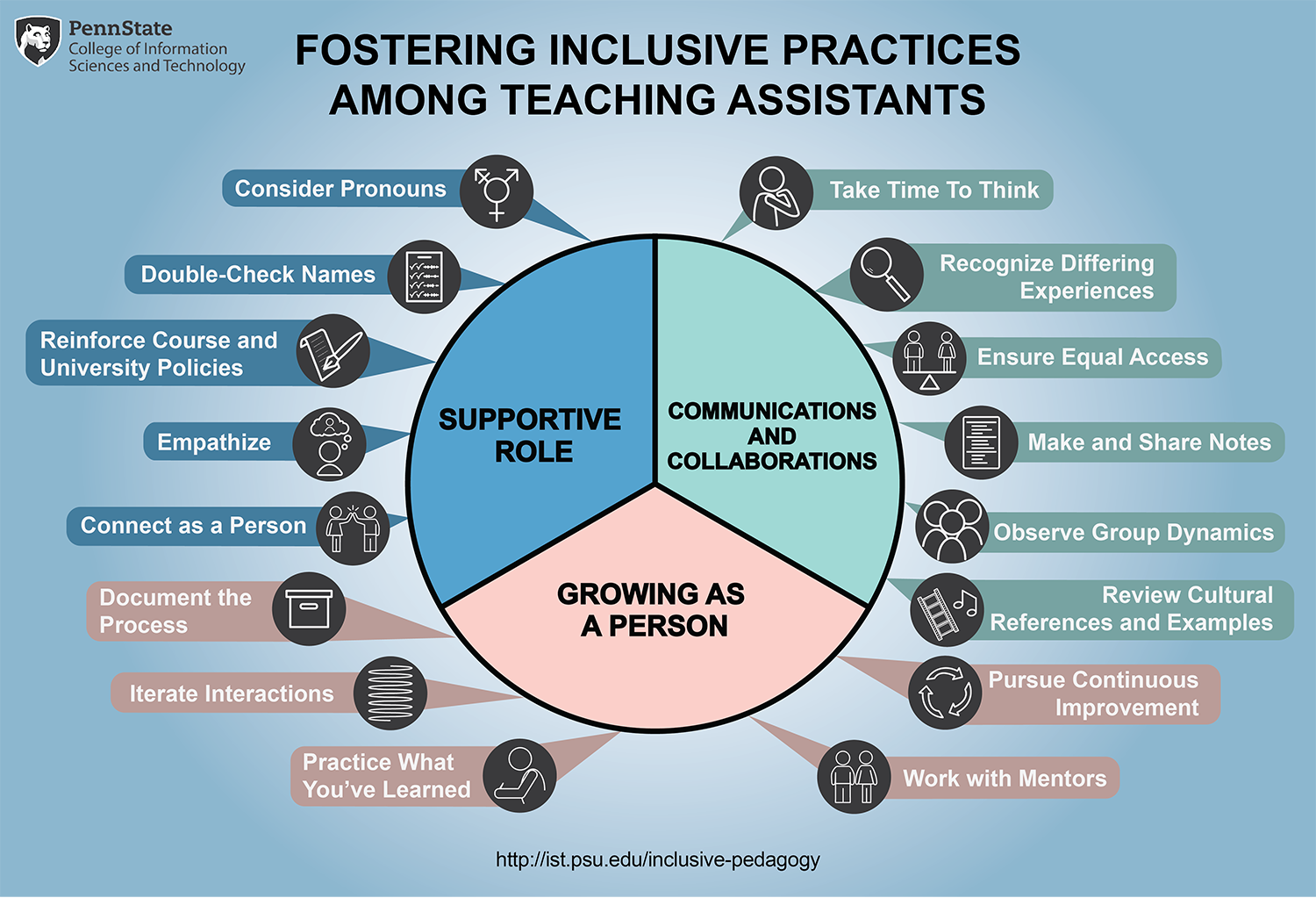Student workers who support teaching practices can use a set of tips and recommendations to help create learning environments that welcome all learners.

In February 2020, I wrote an article for EDUCAUSE Review outlining strategies that can help faculty and instructional designers create learning environments in which all students feel welcome and connected.Footnote1 This article is intended as a companion document, one that supports inclusive teaching for students in roles such as teaching assistants (TAs), tutors, and education technology specialists (i.e., student workers who support edtech tools)—all of whom will be referred to as "teaching assistants."
A broad spectrum of students are—or are becoming—minoritized or marginalized for various reasons (e.g., gender, race, ethnicity, financial status, disability, first-generation college students, and students for whom English is not their first language). For such students, an inclusive learning environment can be an important factor in their academic success. This article provides tips and guidelines for faculty working with teaching assistants, for those responsible for training teaching assistants, and for teaching assistants looking to understand inclusive teaching. I hope that these recommendations and examples offer a new perspective on student needs and strategies for creating caring learning environments.

Establishing a Supportive Role
Individuals working in student support can use thoughtful techniques to connect with students and show them they are there to help ensure student success.
- Connect as a person. Taking the time to introduce yourself and get to know the students you are helping is a key step in your work, but it is also something that can be diminished or completely skipped. An important part of the college experience is the interactions students have in the classroom with the instructor, TA, and other students. Recognize the value that each student brings to the shared course experience. Even sharing something small about yourself, such as your favorite sport or genre of music, helps students see you in a different light and allows them to connect with you.
- Empathize. Although you have a role for educating your peers, you also have an opportunity to connect using empathy. As a current student, you have likely experienced issues navigating school and the stress that comes with that experience. As a learning assistant, tutor, or edtech support specialist, you have excelled in the area for which you are providing help. If you find it difficult to see why a student is struggling with something that you understand easily, reflect on a time when you struggled with academic or professional work. A good place to start the practice of empathizing is to validate the students you are working with and their struggles.
- Double-check names. For a variety of reasons, a student's preferred name might not be the name found in the student information system. Some students have nicknames; others may be exploring their gender identity. Offer students an opportunity to provide a preferred alternative name. Students may also have names that are unfamiliar to you. If so, ask them for pronunciation help or search online for audio clips that can help you practice the pronunciation of unfamiliar names. Because you are their peer, students might be more comfortable with your using nicknames or variations on their name that they might not use with faculty and staff. Asking for and using a preferred name can be an effective way for you to help students feel welcome and valued.
- Consider pronouns. Consider adding your pronouns to your contact information. This offers students an opportunity to share theirs. Keep in mind that while anyone appreciates when you use the correct pronouns, it is not appropriate to introduce this topic in pairs or groups—some students are still exploring their identity, and asking about pronouns at the wrong time could put them in an awkward position. Instead, tell students that you recognize the importance of being called the right pronoun and that they can always reach out to you to make sure you understand their preferences. Although you might just use first names in communications with students, you might benefit from an awareness of gendered and gender-neutral honorifics for your correspondence.
- Reinforce course and university policies. Courses you support might make use of a diversity, equity, and inclusion (DEI) policy, an accessibility policy, or even a policy on professionalism. Such policies show a commitment to your students, but they also establish acceptable classroom conduct for students. Make sure you are familiar with existing course and institutional policies. You can reinforce the policies to support open and inclusive classes by modeling the behaviors the policies address. Further, you can ask your supervisor how to proceed should a student disregard or violate the policy. In certain cases, it might be appropriate for you to provide gentle correction to the student. In other cases, additional help might be needed.
Laying the Groundwork for Respectful Communications and Collaborations
Practicing inclusive communication and collaboration in your role as a teaching assistant will help you develop skills to become a thoughtful and respectful professional.
- Review cultural references and examples. If you are working with students of a similar age as your own, it can be easy to assume that they have a similar cultural experience. Students come from diverse backgrounds, however, which means that their knowledge of books, movies, TV, and even physical spaces and geography will be different from yours. You can still use cultural references, but consider how you might provide multiple examples when possible to elaborate on cultural references. Also, first-generation college students and others who are new to college may not have a strong understanding of academic life. Rather than asking students, "Do you know about X?" (which might force them to claim that they know something that they don't), inform the student that "if you want, we can talk more about X," which invites them to drive the conversation.
- Recognize differing experiences. Not all students learn the same way. What might have been easy or challenging for you could be different for someone else. You might not be able to rely on the apprenticeship of observation or teaching how you were taught.Footnote2 Instead, you might need to consider new ways of teaching course material to help students succeed in their academic pursuits.
- Observe group dynamics. Group work can be both frustrating and rewarding, depending on how the group functions. Given the opportunity, watch how the group interacts. To promote inclusivity in this experience, look for behaviors of dominance and withdrawal. Students who dominate might think they are helping the group by providing leadership. However, it is important to ensure that the other group members are also helping guide the work. Moreover, instead of assuming that students are social loafing, be aware that students who appear to have withdrawn from the group work may have done so for any number of reasons (in response to dominant group members, feeling isolated, feeling overwhelmed, etc.). Withdrawn students may require additional encouragement from faculty and other support staff. In either case, ask the group about contribution and the discussion points they have made throughout the work. This will help uncover an imbalance in effort.
- Take the time to think. Silence can be used to give all students time to reflect before they speak. Such reflection time can help students formulate their ideas. Although you might feel like you're not helping during that silence, remember that when pauses are used strategically, you're giving students time to consider before responding. Secondarily, you might also consider asking students to share their thought processes by thinking out loud. When students are struggling, this can be a useful tool to pinpoint the challenge they are facing and offer strategies around the issue.
- Make and share notes. Consider making notes or creating a collaborative document where you and the students you're working with can take notes. When students are learning a new topic, they can be overwhelmed by the learning at the moment and may not remember everything that was discussed. A shared document helps ensure that notes are clear and without misunderstanding. This practice also models the skill of notetaking, something to develop alongside learning the content of the class. This approach also supports students with physical and cognitive disabilities and those for whom English is not their first language.
- Ensure equal access. A good question is worth sharing. When a student asks a general question about content or an assignment, sharing that question with the rest of the class can be valuable. Consider creating an announcement for the class capturing the question and the answer and/or any clarification. For tutors, a useful approach might be to create a "frequently asked questions" document that can be shared more broadly. This approach can help many students and offers a way to make one-on-one work more efficient since it can allow you to get directly to the specific needs of the students.
Growing as a Person
Developing inclusive practices isn't just isolated to your role as a teaching assistant. Rather, it is a lifelong pursuit of improvement and personal development.
- Iterate interactions. Each time you engage with students is an opportunity to iteratively improve. Consider your practices, identify how you might improve, and make a conscious effort to welcome and support students.
- Work with mentors. In your position as a teaching assistant, find others you can learn from. As you continue to develop your skills, you will find importance in a diversity of mentors because you can learn many different things from different people.
- Practice what you've learned. This article describes considerations for inclusive teaching practices, but the skills you develop in this context can be translated to other situations. The ability to be an inclusive and collaborative professional is a very important skill, and you can continue to develop your abilities in different areas, such as clubs, internships and your own coursework.
- Document the process. When you're developing skills to become a more inclusive teaching assistant, consider how you might include this effort in your portfolio of work. This might come in the form of a reflection on how your approach to teaching incorporates inclusivity or a set of examples that demonstrate your work in this area.
- Pursue continuous improvement. Consider taking workshops and engaging in other professional development opportunities to improve your understanding of inclusion. Share your work with peers, and engage in discussions on how to apply what you have learned.
Coordinating with Your Teaching Team
Your role as a teaching assistant is to help faculty and other students. Work with your faculty and other teaching assistants in your teaching team to discuss the practices suggested above, how they might fit in the context of your role, and the kinds of classes you support. Coordinating these efforts can further improve the experience of students and refine your thinking on these practices.
You might find that some practices fit well and can be easily implemented, while others are more challenging. Just remember that progress is made one step at a time.
Notes
- Chris Gamrat, "Inclusive Teaching and Course Design," EDUCAUSE Review, February 6, 2020. Jump back to footnote 1 in the text.
- Dan C. Lortie, Schoolteacher: A Sociological Study (Chicago: University of Chicago Press, 1975). Jump back to footnote 2 in the text.
Chris Gamrat is an Instructional Designer at Penn State University.
© 2021 Chris Gamrat. The text of this work is licensed under a Creative Commons BY 4.0 International License.
